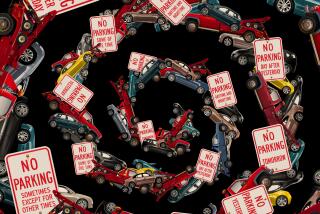Driver Tells How FasTrak Error Stalled in Slow Lane
Question: I read your article on tollway cheaters (“Cracking Down on Repeat Tollway Violators,” Highway 1, May 15), and I would like to point out that there is a flip side to this issue.
Last summer I received three notices of tollway violations for the 91 Freeway’s FasTrak lanes--all stating that my car was there about 5:30 a.m.
The problem is I have never driven in these lanes. In fact, on the date of the first violation, my car was parked at Los Angeles International Airport’s Lot B while I was in Indiana.
I am still being hounded for payment of these fines despite providing a receipt for the LAX parking. My request for positive proof of the violation has been ignored.
Obviously, the system is flawed, but drivers are not the only ones who are cheating.
Chris Zarow
Answer: Zarow’s story sounds like a “Twilight Zone” episode. How could her vehicle have mysteriously shown up on the 91 Freeway three times when she says she was nowhere near it?
“I knew they had no proof that my car was on the FasTrak lane,” said Zarow, an assistant professor of neurology at USC’s Rancho Los Amigos National Rehabilitation Center.
Zarow said she sent the tollway’s operators an affidavit and a second letter explaining that her vehicle had been wrongly identified. She demanded to see photographic evidence or other proof that her vehicle had been on the tollway at 5:30 a.m. on July 19 or on the two other dates in question.
The only response she received, she said, was a letter telling her to pay up.
It turns out, though, that Zarow was telling the truth.
Her car’s license plate number is nearly identical to that of a FasTrak motorist who was responsible for the violations, said Greg Hulsizer, general manager of California Private Transportation Co. The company owns and operates the tollway, which stretches from Orange County into Riverside County in privately built center lanes of the 91 Freeway.
When the real culprit used the tollway without using the required transponder that identifies paid-up customers, Hulsizer said, the license plate was photographed.
But when tollway employees reviewed the photos, he said, the letter “T” on the plate was misread as an “I”--and that made it match the license plate on Zarow’s vehicle.
It’s uncommon, Hulsizer said, but license plate numbers and letters can be obscured by the frame around the plate or by shadows. The result: ID photos are misread.
He said photographs of license plates are double-checked before violation notices are sent.
“But we are only human. Sometimes mistakes do get made,” Hulsizer said, and when they do, “we try to make things right as quickly as we can.”
Orange County’s tollways have had their share of problems through the years. It’s not just cheats who sneak free rides--the subject of a current crackdown by the tollway operator and the California Highway Patrol--but also equipment and software glitches that have resulted in backlogs of unpaid citations.
In this case, Hulsizer said, the company did receive Zarow’s affidavit claiming the violation notice was invalid, determined that the offending vehicle was not hers and billed the responsible driver.
Under company policy, Hulsizer said, Zarow should have been notified by mail that she was off the hook.
But Zarow said she never received notification. What she did get was two more notices for violations allegedly occurring about the same time in the morning on different days.
Apparently, the paperwork did not catch up with her case in time to clear Zarow of the other alleged violations.
“Those notices went out before we got her affidavit,” Hulsizer said.
And when those notices went unpaid, the company passed the bills to a collection company.
Zarow wrote another letter and the tollway operator investigated the problem, but Hulsizer was unable to explain why Zarow never heard anything.
Last week, though, after our call to California Private Transportation, Zarow learned she had been cleared of the violations.
“She doesn’t have to worry now,” Hulsizer said.
Although Zarow is relieved to have the matter resolved, it took 10 months from the time she received her first violation notice.
After all that, she said, “somebody dropped the ball here.”
*
Jeanne Wright cannot answer mail personally but responds in this column to automotive questions of general interest. Write to Your Wheels, Business Section, Los Angeles Times, 202 W. 1st St., Los Angeles, CA 90012. E-mail: [email protected].
More to Read
Sign up for Essential California
The most important California stories and recommendations in your inbox every morning.
You may occasionally receive promotional content from the Los Angeles Times.










